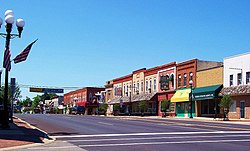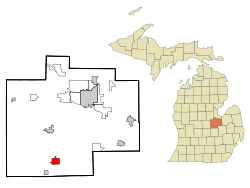Chesaning, Michigan
| Chesaning, Michigan | |
|---|---|
| Village | |
 |
|
 Location of Chesaning, Michigan |
|
| Coordinates: 43°11′2″N 84°7′4″W / 43.18389°N 84.11778°W | |
| Country | United States |
| State | Michigan |
| County | Saginaw |
| Government | |
| • President | Joseph Sedlar |
| Area | |
| • Total | 3.14 sq mi (8.13 km2) |
| • Land | 3.05 sq mi (7.90 km2) |
| • Water | 0.09 sq mi (0.23 km2) |
| Elevation | 627 ft (191 m) |
| Population (2010) | |
| • Total | 2,394 |
| • Estimate (2012) | 2,362 |
| • Density | 784.9/sq mi (303.1/km2) |
| Time zone | Eastern (EST) (UTC-5) |
| • Summer (DST) | EDT (UTC-4) |
| ZIP code | 48616 |
| Area code(s) | 989 |
| FIPS code | 26-15140 |
| GNIS feature ID | 0623168 |
| Website | www |
Chesaning (/ˈtʃɛsənɪŋ/ CHE-sə-ning) is a village in Saginaw County in the U.S. state of Michigan. The population was 2,394 at the 2010 census. The village is located within Chesaning Township.
The first mention of Chesaning in the written pages of history is the Saginaw Treaty, signed in 1819. This treaty was between members of the Saginaw Tribe, Chippewa Indians and the government of the United States. They established a number of reservations, including 10,000 acres (40 km2) along the banks of the Shiawassee River known as "Big Rock Reserve." Chesaning is a Chippewa word meaning "big rock place". The treaty continued in effect until 1837 when a second treaty led to the reserve being surveyed and offered for sale in 1841. The first land was sold at $5 per acre to brothers Wellington and George W. Chapman, and Rufus Mason. After making their land purchase, they traveled back to Massachusetts and moved their families to their new wilderness home by late summer of 1842.
During the months they had been away from their land, several settlers had moved into the area, building a dam and a sawmill. A few years later, a grinding mill was added. The new settlers named their community "Northampton" in honor of the home they had left in Massachusetts. In 1853, the legislature changed the name to Chesaning, the traditional name for the village and township. The first township elections, held in 1847, are considered to be the official birthday of the community. The village, first surveyed in 1851, was organized in 1869. The early business community was located on the east side of the river. The forest setting provided an abundance of lumber, which was used to construct many stores. However, the use of coal heating systems often caused major fires, which destroyed entire blocks of stores. The fires and the arrival of the railroad on the west side community influenced the business area to move on the west side of the river.
...
Wikipedia
